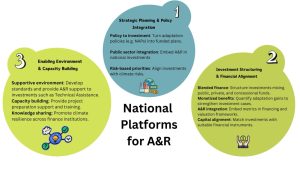Welcome to the first instalment of Cadlas’ new insight blog series, Resilience Unpacked, where we explore key topics in climate resilience financing. In this edition, we focus on National Platforms for Adaptation and Resilience Investment.
We’ll explore how these platforms can serve as crucial mechanisms for financing climate adaptation and resilience initiatives. Specifically, we’ll define what they are and examine how they function, while highlighting the key role they can play in mobilising finance for adaptation and resilience.
What Are National Platforms and Why Do They Matter for Adaptation & Resilience?
National Platforms for climate action, or more commonly called country platforms, are government-led partnerships that bring together multiple stakeholders including the private sector and development finance partners to coordinate efforts, align financing and support national priorities. They act as investment coordination hubs, connecting national climate policies with financeable projects by fostering collaboration, streamlining funding and enhancing the impact of climate-focused development initiatives.
Mobilising Finance for Adaptation & Resilience
Regarded as key coordination mechanisms, national platforms have begun to play an increasingly vital role in advancing national climate goals. Their significance was underscored in the United Nations Framework Convention on Climate Change’s (UNFCCC) 2023 Global Stocktake, where they were highlighted as instrumental in facilitating the implementation of the third round of Nationally Determined Contributions (NDCs). But how do they relate to adaptation and resilience?
While many of these platforms focus primarily on climate mitigation, such as the International Partners Group (IPG) supported Just Energy Transition Partnership (JETP), national platforms also have the potential to play a crucial role in scaling up and mobilising finance for adaptation and resilience. They can offer focus and ownership over national and local adaptation priorities and coordinate investment efforts by bridging the gap between high-level adaptation strategies, like National Adaptation Plans (NAPs), and financeable investments.
The diagram below illustrates how national platforms can utilise country-level strategies to align financial flows with adaptation needs:

Mainstreaming Adaptation & Resilience Across the Investment Pipeline
National platforms mainstream adaptation and resilience considerations across the investment pipeline by integrating it into their strategy, operations, and decision-making processes. They achieve this via three key functions: Strategic Planning & Policy Integration, Investment Structuring & Financial Alignment, and Enabling Environments & Capacity Building.
The diagram below illustrates how national platforms function by integrating and mainstreaming adaptation and resilience considerations across the investment pipeline:

Strategic Planning & Policy Integration
National platforms play a vital role in turning national adaptation policies into investable plans and mobilising the necessary domestic and international resources. They create opportunities for government bodies, such as finance ministries, to collaborate with key stakeholders, ensuring adaptation and resilience are embedded into public investment programmes. By translating physical climate risks into investment priorities, they help develop pipelines that align with the risk-return expectations of financiers, making adaptation a more attractive and viable investment.
Investment Structuring & Financial Alignment
National platforms support the structuring of investment programmes that blend public, private and concessional finance to crowd-in commercial capital and ensure that investments meet investor requirements. They also help capture and monetise the full range of adaptation benefits including avoided losses, enhanced resilience and broader sustainable development benefits, strengthening the business case for investment. They also facilitate the integration of adaptation and resilience metrics into investment appraisal frameworks, ensuring that projects can be matched with the right financial instruments and capital types, making it easier to mainstream adaptation into investment decisions.
Enabling Environment & Capacity Building
Beyond finance, national platforms help establish the necessary, enabling environment for adaptation investment through facilitating technical assistance, promoting the development of metrics/standards and promoting the integration of adaptation and resilience into financial supervision. They also play a key role in supporting project preparation, building institutional capacity and fostering knowledge sharing across the financial sector.
Looking Ahead – Strengthening National Platforms for Climate-Resilient Growth
In conclusion, national platforms have the potential to be powerful drivers of adaptation and resilience finance, turning policy ambitions into investable projects.
By integrating adaptation and resilience considerations across the investment pipeline, they foster collaboration, align financial flows and embed adaptation and resilience into national investment decision-making. As the need for adaptation finance continues to rise, strengthening and expanding these platforms will be key to unlocking the full potential of climate resilience investments and building a more climate-resilient future.
To scale climate adaptation finance, national platforms must:
- Expand beyond being primarily mitigation-focused and fully integrate adaptation & resilience
- Align financial flows with adaptation goals for long-term climate security
- Strengthen cross-sector collaboration to foster holistic adaptation strategies
By providing a holistic overview of key stakeholders’ inputs and country needs, national platforms help direct financial flows and facilitate partnerships.
In part 2 of this Resilience Unpacked series on National Platforms, we’ll dive deeper into how National Platforms are structured and organised, and the various kinds of stakeholders that are involved. Stay tuned!
Other Articles




